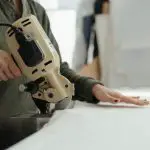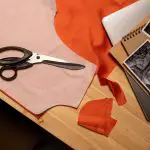Looking for the perfect fabric scissors?
Did you know that a survey found that 87% of experienced sewers consider the type of fabric scissors essential for achieving precise cuts?
In 'Which Fabric Scissors Make the Cut,' you'll explore the different types of fabric scissors, from blade materials and handle design to cutting performance and specialty scissors for unique needs.
Discover the best practices for maintenance and care, and gain expert tips for choosing the right fabric scissors for your projects.
Whether you're a seasoned seamstress or a passionate quilter, mastering the art of selecting the perfect fabric scissors is crucial for achieving professional results in your craft.
Key Takeaways
- There are different types of fabric scissors available, including all-purpose fabric scissors, precision scissors with fine, pointed tips, and fabric shears with longer blades.
- Blade materials and construction play a crucial role in the performance of fabric scissors, with options like high-quality steel alloys, titanium-coated blades, precision grinding and laser-cutting technology, micro-serrated edges, and convex blade edges.
- Handle design and ergonomics are important considerations, with comfortable handles, ergonomic designs that fit the natural curve of your hand, and non-slip grips being key features.
- Cutting performance and precision depend on factors such as blade sharpness, comfortable handle design, durability and long-lasting performance, and the use of high-quality materials. Regular maintenance and sharpening are also essential to maintain blade sharpness.
Types of Fabric Scissors
When choosing fabric scissors, consider the various types available to find the best fit for your specific needs. Proper maintenance and sharpening techniques are essential for keeping your fabric scissors in top condition.
There are several types of fabric scissors to choose from, each designed for specific purposes. For general cutting tasks, all-purpose fabric scissors are a versatile choice. They're suitable for a wide range of fabrics and can handle various cutting techniques.
If you work with delicate fabrics such as silk or satin, consider using precision scissors with fine, pointed tips to ensure accurate cutting without causing snags or fraying.
For tasks that require long, straight cuts, such as quilting or garment construction, consider using fabric shears. These shears have longer blades that enable smooth and precise cutting of large fabric pieces.
Regardless of the type of fabric scissors you choose, regular maintenance and proper sharpening techniques will ensure that they continue to provide clean and precise cuts for your projects.
Blade Materials and Construction
To ensure the continued effectiveness of your fabric scissors for various cutting tasks, it's important to understand the role of blade materials and construction. Blade material selection and cutting edge technology play a crucial role in determining the performance and durability of fabric scissors.
Here are some key points to consider:
- Blade Material Selection: The type of material used for the blades of fabric scissors can greatly impact their performance. High-quality steel alloys, such as stainless steel or carbon steel, are often preferred for their durability and sharpness retention. Titanium-coated blades are also gaining popularity due to their enhanced resistance to corrosion and adhesion, resulting in smoother cutting experiences.
- Cutting Edge Technology: Advanced blade construction techniques, such as precision grinding and laser-cutting technology, contribute to the sharpness and precision of fabric scissors. Scissors with micro-serrated edges provide improved grip on slippery fabrics, while convex blade edges ensure clean and effortless cuts.
Understanding the significance of blade materials and construction will enable you to make informed decisions when selecting fabric scissors, ensuring that they meet your specific cutting needs with efficiency and longevity.
Handle Design and Ergonomics
The handle design and ergonomics of fabric scissors play a vital role in ensuring that you can comfortably and efficiently utilize the cutting tool, enhancing both precision and comfort during extended use.
Handle comfort is crucial for minimizing hand fatigue and strain, especially during long cutting sessions. Look for scissors with ergonomic handles that are designed to fit the natural curve of your hand, providing a comfortable grip and reducing the risk of discomfort or injury.
Additionally, consider the grip design, which can vary from soft cushioned handles to those with contoured finger loops. A non-slip grip is essential for maintaining control and stability, allowing for more precise cutting motions.
When selecting fabric scissors, pay attention to the handle design and ergonomics to ensure that you can work with ease and accuracy, ultimately enhancing your cutting experience. By prioritizing handle comfort and grip design, you can elevate your cutting efficiency and overall satisfaction with the scissors.
Cutting Performance and Precision
When it comes to fabric scissors, there are several important factors to consider for optimal performance.
Blade sharpness is crucial for precise cutting. A sharp blade will effortlessly glide through fabric, ensuring clean and accurate cuts. Dull blades, on the other hand, can result in frayed edges and uneven lines.
In addition to blade sharpness, a comfortable handle design is essential for maintaining control and reducing hand fatigue. Cutting fabric can be a repetitive task, so it's important to choose scissors with ergonomic handles that fit comfortably in your hand. This will allow you to work for longer periods without discomfort or strain.
Furthermore, durability and long-lasting performance are key factors to consider when evaluating cutting performance and precision. Fabric scissors that are made from high-quality materials are more likely to withstand frequent use and maintain their sharpness over time. Investing in a durable pair of fabric scissors will save you money in the long run and ensure consistent, reliable cutting performance.
Blade Sharpness Matters
For precise and efficient cutting, sharp blades are essential when using fabric scissors. Blade sharpness directly impacts cutting performance and precision. Here's why blade sharpness matters:
- Clean Cuts: Sharp blades effortlessly slice through fabric, resulting in clean and precise cuts without fraying or snagging.
- Reduced Effort: Sharp blades require less force, reducing hand fatigue and allowing for smoother, more controlled cutting techniques.
- Accuracy: Sharp blades enable greater accuracy, ensuring that intricate patterns and detailed designs are executed with precision.
When selecting fabric scissors, prioritize blade sharpness to optimize cutting performance and achieve professional-level results.
Regularly maintain and sharpen your blades to uphold their sharpness and maximize their cutting effectiveness.
Comfortable Handle Design
To achieve optimal cutting performance and precision, prioritize a fabric scissor handle design that provides comfortable and ergonomic support for your hand and fingers. A comfortable grip is essential for reducing hand fatigue and ensuring precise cutting control. Look for scissors with soft, cushioned handles that fit comfortably in your hand, allowing for extended use without discomfort.
Ergonomically designed handles can help distribute pressure evenly across your fingers, reducing the strain on your hand and wrist. This not only enhances cutting performance but also minimizes the risk of hand fatigue during long cutting sessions.
When selecting fabric scissors, pay close attention to the handle design to ensure it promotes comfort and reduces the potential for hand fatigue, ultimately contributing to improved cutting precision and overall performance.
Durability and Long-Lasting
With a focus on ensuring durability and long-lasting cutting performance and precision, you want to select fabric scissors that maintain their sharpness and cutting effectiveness over time, allowing you to achieve consistent and accurate results.
When considering durability and long-lasting features in fabric scissors, keep in mind the following:
- Material Quality: Look for fabric scissors made from high-quality stainless steel or titanium, ensuring long-lasting sharpness and durability.
- Blade Maintenance: Opt for fabric scissors with detachable blades or a self-sharpening feature to maintain sharpness and cutting precision over time.
- Precision Engineering: Choose fabric scissors with precision-engineered blades and a solid construction to ensure long-lasting cutting performance without compromising accuracy.
Specialty Scissors for Unique Needs
When cutting intricate patterns or delicate fabrics, precision becomes paramount. For left-handed individuals or specialized needs, the right pair of scissors can make all the difference in your sewing projects or crafting endeavors.
Left-handed scissors are specifically designed to provide comfort and accuracy for left-handed users, ensuring clean cuts without any awkward hand positioning. Additionally, specialized shears are available for unique requirements such as pinking shears for decorative edges, appliqué scissors for intricate detailing, and embroidery scissors for fine, delicate work. These specialty scissors are tailored to meet the demands of specific tasks, allowing you to work with greater ease and efficiency.
For crafting scissors, look for options with ergonomic handles and precision blades, ideal for cutting through various materials with ease. Whether you're working with paper, cardboard, or light fabrics, having the right crafting scissors can significantly enhance your crafting experience.
When selecting specialty scissors, consider the specific needs of your project and choose scissors designed to meet those requirements. By investing in the right tools for your unique needs, you can elevate the quality and precision of your work while enjoying a more comfortable and efficient crafting experience.
Maintenance and Care Tips
Proper maintenance and care of your fabric scissors is essential for preserving their sharpness and longevity. To ensure your fabric scissors remain in optimal condition, follow these maintenance and care tips:
- Cleaning Techniques: After each use, wipe the blades with a clean, dry cloth to remove any lint, dust, or residual fabric fibers. For a more thorough clean, use a soft cloth dampened with mild soap and water. Dry the scissors completely before storing them.
- Storage Solutions: Store your fabric scissors in a dry environment to prevent rust and corrosion. Consider using a dedicated scissor sheath or case to protect the blades from damage and to keep them safely stored when not in use.
- Avoiding Rust, Preventing Damage: To prevent rust, avoid exposing your fabric scissors to moisture or harsh chemicals. Additionally, refrain from using them on materials that could dull or damage the blades, such as paper or cardboard.
Choosing the Right Fabric Scissors
When it comes to choosing the right fabric scissors, the blade material plays a crucial role in determining their performance and longevity.
Additionally, comfort and ergonomics are essential factors to consider to ensure a smooth and comfortable cutting experience.
Blade Material Importance
To choose the right fabric scissors, consider the blade material's durability and sharpness for efficient cutting. The blade material is crucial for optimal performance and longevity of the scissors. When selecting fabric scissors, prioritize blade durability and edge retention.
Consider the following when evaluating blade material:
- Durability: Look for scissors made from high-quality stainless steel or titanium for long-lasting durability.
- Sharpness: Choose a blade material known for its excellent edge retention, such as high-carbon steel, to ensure long-lasting sharpness for precise cutting.
- Resistance to Corrosion: Opt for a blade material that's resistant to corrosion, such as stainless steel, to maintain the quality of the scissors over time.
Selecting fabric scissors with the right blade material will ensure efficient and precise cutting for your fabric projects.
Comfort and Ergonomics
Have you ever struggled with hand fatigue while using fabric scissors for extended periods of time?
The key to combating hand fatigue lies in the design of the scissors' handle. When selecting fabric scissors, consider those with an ergonomic grip. This type of handle is specifically designed to reduce strain on your hand and fingers, allowing for more comfortable and prolonged use.
An ergonomic grip promotes a more natural hand position, which can alleviate tension and discomfort during use. By choosing fabric scissors with an ergonomic grip, you can significantly reduce the likelihood of experiencing hand fatigue, enabling you to work on your projects for longer periods with ease.
Prioritizing comfort and ergonomics in your fabric scissor selection can greatly enhance your cutting experience.
Frequently Asked Questions
How Do I Know if I Need to Replace My Fabric Scissors?
You can tell it's time to replace your fabric scissors when the blade starts to dull, causing frayed edges and difficulty cutting. Regular maintenance and proper cutting technique can help prolong their sharpness.
Can Fabric Scissors Be Used for Cutting Other Materials Like Paper or Plastic?
Yes, fabric scissors can be used for cutting paper or plastic, but it's best to use metal fabric scissors for other materials. They retain sharpness better than plastic ones, ensuring clean cuts.
Are There Any Safety Tips for Using Fabric Scissors?
When using fabric scissors, it's crucial to maintain a proper grip to ensure safety. Always be mindful of the sharp blades, and never run with them or leave them unattended. Stay focused and handle with care.
Can Left-Handed Individuals Use the Same Fabric Scissors as Right-Handed Individuals?
Yes, left-handed individuals can use specific left-handed scissors designed for their comfort. There are also ambidextrous options available that work well for both right and left-handed users. These options ensure ease and precision for all.
Are There Any Environmental Considerations When Choosing Fabric Scissors, Such as Recyclability or Eco-Friendly Materials?
When choosing fabric scissors, consider environmental impact. Look for eco-friendly materials, recyclability, and sustainable production to minimize your carbon footprint. Opt for scissors made from recycled or biodegradable materials for a greener choice.
- Tetron Fabric for Marine Applications: Durability and Use Cases - June 18, 2025
- Tetron Fabric for Outdoor Furniture: Weather Resistance and Care - June 18, 2025
- Tetron Fabric for Wall Coverings: Style and Application Tips - June 18, 2025





